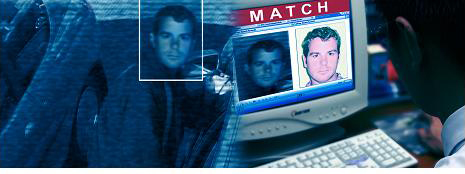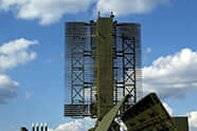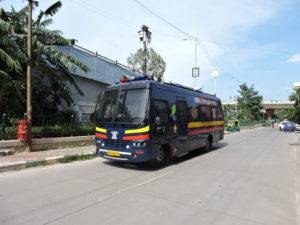Face Recognition Surveillance Systems
A post in this month’s Homeland Security Tech. Brief – New Technologies in Biometrics – talks about 3-D Face Recognition in connection with new technologies in the biometrics field. While 3-D Face Recognition Software may be useful in controlled environments (since capturing the facial information requires a structured-light setting); nowadays, traditional 2-D images can be used in real-life settings, with much better results, thanks to new software tools and more advanced analysis techniques. This post describes a practical implementation of Face Recognition surveillance Systems, using a mix of high-resolution cameras and a biometric identification system application suite.
Face Recognition Software User Requirements
Law-enforcement agencies typically use Facial Recognition Software to identify criminals or terror-suspects in public spaces, at entry points (airports, border crossings, road check posts, etc.), and during search-and-capture missions. The nature of use can involve fixed or mobile settings, in either standard or rugged enclosures, with the back-end processing carried out locally or remotely. Under the circumstances, the Face Recognition Surveillance Systems should support configurations for different settings, should work in both wired and wireless modes, and should be capable of connecting to a broadband backhaul to a back-end image processor.
Face Recognition Surveillance Systems – User Issues
Traditionally, face recognition surveillance systems have suffered from high false positives/negatives on account of the following reasons:
- Quality of captured image
The captured image is significantly different from the reference image in the database: this can be on account of a lower image-capture resolution, differences in lighting, a different profile of the captured image, or high noise in the image-capture environment (rain, dust, etc.). - Camouflage
Potential suspects may make superficial changes to their appearance to evade identification. These changes may be shaving one’s head, growing a beard or removing one, growing or removing a moustache, etc. - Volume of human traffic
In high-footfall or high-density spots, a face-recognition system gets overwhelmed by the number of faces to capture, analyse, and report on. In India, this is a common occurrence, given the volume of human traffic in most public spaces. - Real-time response
Once a face is captured, the ability of older face-recognition systems to respond in real-time has been an issue. This, in conjunction with the previously mentioned reason, results in face-recognition systems failing to perform in real-life situations. - Insufficiently detailed reference database
The reference database used by law-enforcement agencies is itself, sometimes, of questionable quality; in which case, howsoever good the input, the output triggers high false positives/negatives.
 |
| Image Source: www.l1id.com |
High-resolution Face Recognition
A high-resolution Face Recognition Surveillance Systems consist of three subsystems, each playing an important part in delivering a solution that features a low FAR/NAR (False/Nuisance Alarm Rate):
The advent of 3D face recognition has made this technology accurate, fast and as simple as fingerprint recognition.
3D face biometrics is based on anthropometric data – precise measurements of cranial structure and rigid tissues. The 3D biometric template (feature vector) is extracted from extremely precise geometric data (sub-millimeter measurements) about the cranial curvature is those areas where rigid tissues are most visible (for example eye sockets, superciliary arches, chin zone, the bridge of a nose). These areas are the most unique and are unchanging over time, and therefore robust to aging or weight changing in the subject.
The structured light approach to 3D face recognition, eliminates concerns about poor lighting conditions, structured light 3D technology uses its own light source. Structured light 3D face-readers shine an invisible near infrared pattern of a grid on a user’s face and then maps the geographic pattern of the face based on the distortions it causes in the grid pattern.
This post describes a practical implementation of a Face Recognition Software, using a mix of high-resolution cameras and a biometric identification system application suite. Accommodate a number of facial positions, making the verification process simple for users who need to only pause in front of the reader on their way in.
3D Face Recognition Software using structured light approach has a number of unique advantages:
- High-Resolution surveillance camera
The image capture takes place using very high-resolution cameras. These cameras support a resolution of 5 MP (megapixels) or higher (up to 16 MP). The frame rates for these cameras will typically be 15fps (frames per second) or lower, depending on the resolution. The low frame rate is not an issue in face-recognition applications, as the objective is to capture a face in high detail, rather than capture a visual scene in high-fidelity. The cameras also support WDR (Wide Dynamic Range), allowing high-quality imaging even in low-light and extreme-light conditions.
If required, the data from the cameras can be supplemented by data from other biometric sensors, to further refine the identification process.
- Face recognition software application suite
With the increasing computing power now available on edge-devices (cameras), many image-processing functions are executed on the edge-device itself. However, given the complexity of image-processing required in the case of face-recognition, in order to ensure a low FAR/NAR, the best face-recognition solutions today still work at the back-end. The Face Recognition Software application suite typically consists of a face-screening application, software tools for enhancing the effectiveness and performance of face-recognition, and the face-recognition application.
The images from the surveillance cameras feed into the face-recognition application suite, which then searches them against a reference database, and generates real-time alarms whenever a match is found. Specialized hardware may be used for the screening, enhancing, and recognition functions.
- Network Fabric
Given that the face-recognition engine runs at the back-end, and that results need to be delivered in real-time, the flow of data from the sensors to the face-recognition application suite needs to be timely. The fabric can either be wired or wireless at the camera network level. The face-recognition engine can be located in close proximity to the camera network or in a remote location and, accordingly, the network fabric connecting the camera network to the Face Recognition Software can be a wired backbone or a wireless backhaul network.
Conclusion
Face recognition, as a security application, has reached a level of maturity that allows it to be deployed for critical situations. There are still issues of high volumes overwhelming the system or of reference databases of questionable quality, but these are issues that can be resolved through the use of well-planned processes and through careful creation of master databases, respectively.
Mistral offers a range of IP surveillance cameras, Face recognition Software and accessories, across a range of resolutions and features that support Face Recognition Surveillance Systems. Mistral is also a partner of L1 Identity Solutions, a premier global identity management provider. L-1 ID provides a full range of Face Recognition Software, finger/palm, face, iris, and multi-biometric products for government-sponsored civilian identification management programs and criminal identification management procedures managed by law enforcement and military agencies.



